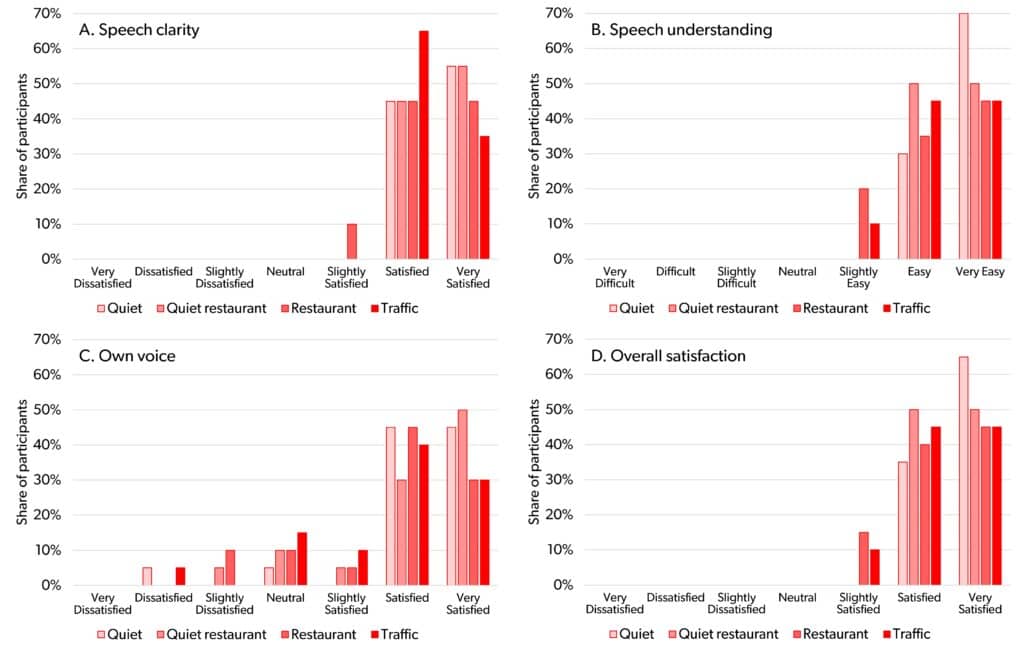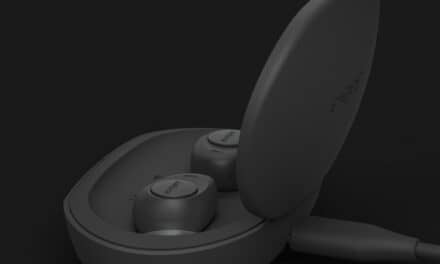HandsFree and CallControl in Signia AX deliver a great phone experience for the wearer and the conversation partner.
By Eric Branda, AuD, PhD; Niels Søgaard Jensen, MSc; Sonie Harris, AuD; Jennifer Weber, AuD
Abstract
This article presents the outcome of a study investigating the Signia Augmented Xperience (AX) HandsFree and CallControl for iOS functionality that allows wearers to conduct hands-free phone calls. The study demonstrated a highly satisfying phone experience for the wearer and conversation partner alike.
Introduction
Streaming sound directly from a smartphone to hearing aids using Bluetooth wireless protocols has been an integral part of modern hearing aid technology for several years. The technology has allowed hearing aid wearers to stream phone calls directly into their hearing aids, resulting in better sound quality and a substantial reduction of problems with acoustic feedback and other artifacts, which traditionally have caused challenges and limited satisfaction when wearers are talking on the phone while wearing hearing aids.1 Signia strives to provide an optimal telephone streaming experience and has offered several streaming solutions, resulting in high levels of wearer benefit and satisfaction.2,3
With the introduction of HandsFree for iOS, Signia has taken the next step to improve the phone experience for hearing aid wearers. It is now possible for wearers of Signia Augmented Xperience (AX) hearing aids to use their hearing aids as a headset for hands-free phone calls. This hands-free experience is achieved by streaming sound both to and from the smartphone and the hearing aids. By using the hearing aids’ microphones to pick up the wearer’s voice, this hands-free system no longer relies on the smartphone’s microphone.
The wearer’s experience is further enhanced by CallControl, which allows the wearer to accept/reject an incoming call and end a call by simply touching the hearing aids.
Considering this new functionality, a study was conducted at the University of Northern Colorado (UNC) to assess the call quality and usability of the HandsFree and CallControl features.
How it Works
Streaming phone calls to hearing aids alone is not a new technological innovation. The HandsFree for iOS feature, now available in Signia AX, is based on well-known Made for iPhone (MFi) technology. MFi technology has been further developed to support streaming sound the opposite direction – from hearing aids to smartphone.
A key characteristic of HandsFree functionality is use of the hearing aid microphones to pick up the wearer’s voice. This introduces the challenge of maintaining the sound quality of the wearer’s voice as heard by the conversation partner during a call in which the wearer is situated in background noise. To optimize the wearer’s voice, Signia utilizes its state-of-the-art directionality and noise reduction technology into the Handsfree feature, optimizing the signal before streaming it to the smartphone. This approach results in a clear, high-quality phone call for both parties.
Streaming from smartphone to hearing aids has been further refined in Signia AX using two innovative approaches. First, AX split processing reduces interference from ambient noise.4,5 Second, Signia AX offers different streaming gain offsets for different types of streaming. The default settings of the gain offsets have been optimized for Audio, TV, and HandsFree phone streaming, respectively. However, the Hearing Care Professional (HCP) has the option to adjust all gain offsets individually and thereby accommodate the individual preferences of the wearer.
Another major addition for phone use is the CallControl option. For Signia AX hearing aids with a push button or rocker switch, the wearer can accept an incoming call by applying a short press. A long press ends or rejects a call. For the Styletto form factor, where no button is available, calls can be accepted and ended by double-tapping either of the hearing aids. Thus, incoming calls can be handled without having to touch the smartphone at all. Together, the HandsFree and CallControl features provide exceptional wearer phone call functionality that can be tailored to the wearer’s individual needs. For further details on the HandsFree and CallControl functionality in Signia AX, please see the Signia Backgrounder.6
Wearers’ Assessment of Call Quality and Usability
Methods
Twenty people (10 female, 10 male) with a mean age of 68 years (range: 23-85 years) and with mild-to-moderate sensorineural hearing loss (see Figure 1 for mean audiogram) participated in the study. All participants were experienced hearing aid wearers but were not required to have streaming experience.

Participants were fitted bilaterally with Signia Pure Charge&Go AX (RIC) hearing aids with closed domes. The proprietary First Fit rationale was used, and Own Voice Processing 2.0 training was completed. The participants were also fitted with a set of Styletto AX (SLIM-RIC) hearing aids to later assess tapping control usability.
Each participant was equipped with an iPhone 13 smartphone that was paired with their Pure hearing aids, and they were instructed on how to make an outgoing call and how to accept and end an incoming call (using CallControl).
The task was to conduct several short test calls with the test leader (situated in another room) as the conversation partner. The participant and the test leader took turns calling each other to allow for making outgoing calls and accepting incoming calls. CallControl was always used to accept and end calls. All calls were established via Wi-Fi using the Facetime app, but without video.
The test calls were completed in four acoustic scenarios: 1) Quiet, 2) a rather quiet restaurant environment (54 dBA), 3) a louder restaurant environment (63 dBA), and 4) traffic noise (63 dBA). Background noise was presented from two loudspeakers positioned behind the participant.
Following the calls in each scenario, the participant was provided four questions relating to the call quality in that specific environment and asked to rate them on a seven-point Likert-type scale, ranging from “very dissatisfied/difficult” to “very satisfied/easy.”
• How satisfied were you with the clarity of your conversation partner’s voice?
• How easy was it to understand what was being said?
• How satisfied were you with the sound of your own voice?
• How satisfied were you, all in all, with the quality of the phone call?
When all test calls had been completed, the participant was asked to answer five questions on the usability of the HandsFree and CallControl functionality when using the Pure hearing aids:
• How easy was it to answer an incoming phone call?
• How easy was it to end a phone call?
• How satisfied were you with the option to answer and end phone calls by pressing a button on the hearing aid?
• How satisfied were you, all in all, with the hands-free functionality?
When the usability questions had been answered for Pure, the participants switched to the Styletto hearing aids. Instructions and practice using the CallControl tapping functionality were provided. Test calls were then completed, focusing only on the usability of CallControl and not on the sound quality. The usability was assessed by allowing the participant to answer the same usability questions, which were already answered for the Pure device.
Results
The ratings of the four call quality questions are shown in Figure 2. The four panels show the distribution of ratings made in each of the four background scenarios. The general trend indicates high levels of satisfaction for all four questions. For the three questions pertaining to speech clarity, speech understanding and overall satisfaction, all ratings were in the upper half of the rating scale (predominantly at the two highest ratings), indicating overall satisfaction with the sound quality.

For the question regarding own voice, a few ratings were below the midpoint of the scale, suggesting some level of dissatisfaction. This is likely attributed to the use of closed domes and insufficient time to get acclimated to the sound of their own voice. In some cases, an open dome would have been more appropriate and likely improved the own-voice perception.
Not surprisingly, another general trend is that the highest ratings are observed in the two quieter scenarios. However, even in the noisy backgrounds, 45% of participants continue to be “very satisfied” when asked about their overall satisfaction, while 40%-45% stated they are “satisfied.”
The questions on usability pertained to Signia Pure C&G AX (button control) and Signia Styletto AX (tapping control). The distribution of ratings of the usability of HandsFree and CallControl with each form factor are presented in Figure 3.

A similar response pattern was observed for all four usability questions. The ratings were predominantly in the upper end of the scale, with the highest ratings (“very easy” and “very satisfied”) used most frequently, indicating that participants were generally satisfied with the CallControl and HandsFree functionality.
The response patterns were also quite similar for Pure and Styletto. In the first three questions (Panels A-C), the number of maximum ratings provided was slightly higher for Pure, but in the fourth question on overall satisfaction, the response patterns were almost identical, indicating that both form factors’ implementation of the HandsFree feature with CallControl offer a high level of wearer satisfaction.
Conversation partners’ assessment of call quality
In the second part of the study, the experience of the person having a phone conversation with the Signia AX wearer using HandsFree in a noisy environment was assessed.
Methods
In this part of the study, 20 young people with no history of hearing loss participated. The participants (18 female, 2 male) were all graduate students in the audiology program at UNC and familiar with listening tests and the evaluations of sound quality.
The assessment of the conversation partner experience was conducted by listening to pre-recorded sound samples presented via headphones. A pair of RIC hearing aids were positioned on the ears of a KEMAR manikin. The speech signal was a female voice presented from the KEMAR mouth simulator. Two different acoustic scenarios, restaurant and traffic (similar to the sound scenarios used in wearer assessments done in the first part of the study), were presented from five loudspeakers positioned around the KEMAR manikin.
With HandsFree activated, the hearing aids picked up and processed the sound signal and streamed it to an iPhone. Via a Facetime call using a Wi-Fi network, the phone call sound was transmitted to another iPhone, where the sound, as it would be perceived by a conversation partner, was recorded.
Recordings in the two noise scenarios were made using Signia Pure Charge&Go AX hearing aids as well as premium, RIC-style hearing aids from three main competitor brands that offer the same type of hands-free functionality. Thus, the conversation partner experience was assessed for four different sets of hearing aids. The brands will be referred to as Brands A, B, and C, respectively.
The participant was equipped with a set of AKG K712 Pro headphones and placed in front of a monitor. The test procedure was fully automated via a PC using the SenseLabOnline test software. The participant was asked to rate the perceived ease of listening and speech clarity when listening to each combination of hearing aid condition and background scenario. For each scenario, the participant could switch between all four hearing aid conditions and rate each hearing aid by placing a slider on a continuous 0 to 100 scale in which higher ratings indicated better performance. The two attributes were rated in separate trials, and each combination of hearing aid condition and background scenario was rated twice.
Results
The mean ratings for sound each attribute observed in the two noisy scenarios are shown in the two panels in Figure 4. The mean ratings of Signia AX are shown as red bars, while different shades of gray represent the three competitor brands.

The response patterns in both noise scenarios were similar for ease of listening and speech clarity. For both attributes in both noise scenarios, the highest mean ratings were observed for Signia AX. All Signia AX mean ratings were 75 or higher on the 100-point scale, while none of the competitor mean ratings exceeded 70, indicating a higher call quality offered by Signia AX. Among the competitor devices, Brand B consistently received the lowest ratings across scenarios and attributes. Brand A was rated higher than Brand C in the restaurant scenario, while the opposite was the case in the traffic scenario.
The ratings were analyzed using a mixed-model ANOVA. The analysis showed a highly significant main effect of hearing aid brand (p < .00001), and Tukey HSD post-hoc tests showed that the mean rating of Signia AX was significantly higher than the mean ratings for all three competitor brands in both scenarios and for both attributes (all p < .05). Thus, the analysis shows statistically significant benefits in call quality offered to the conversation partner by Signia AX HandsFree compared to the hands-free solutions offered by the three competitors.
While all the hearing aids rely on some of the same underlying MFi technology, there are some unique characteristics of the Signia AX technology that explain the superior experience reported by the conversation partner. One is the directional microphone technology used to pick up the wearer’s voice. By steering the microphone beam toward the voice originating from the wearer’s mouth, it is possible to maintain the vocal quality of the talker – even in the presence of background noise. The quality is further enhanced by Signia AX’s advanced noise reduction technology before the signal is streamed to the smartphone. The overall result is a clear and easy-to-understand speech signal transmitted to the smartphone. As the results of this study demonstrate, this implementation of advanced signal processing as part of the HandsFree feature results in improved ease of phone communication for the conversation partner and the wearer.
Discussion
The results of the study indicate use of the Signia HandsFree generates high satisfaction levels in two ways. One, for the wearer, high ratings of call quality and usability were recorded. Two, for the conversational partner, the call quality was rated significantly higher than the quality offered by three other hearing aid brands. These results demonstrate how the signal processing available in Signia AX leads to superior phone use outcomes for the wearer and conversation partner when HandsFree is used.
One usability factor we investigated was whether the use of a push-button would be easier to manage than the double-tap. The brief training provided in this study was adequate for participants to handle the tapping reliably when using the Styletto. Some participants preferred Pure over Styletto, but interestingly, there were also participants who had the opposite preference. For example, a few participants with reduced sensitivity of their fingertips stated that they found the tapping for the Styletto was easier than having to find and push the button on the Pure hearing aid. This is a relevant finding, considering the relatively large number of wearers with finger dexterity issues.
While the test conditions in the study were meant to simulate use in real life, there are external conditions that may affect the performance of the HandsFree feature. The quality of the wireless communication between both phones directly impacts call quality. This connection may be established in numerous ways, based on Wi-Fi or cellular networks of varying quality and strengths, and it is not stronger than its weakest link. This holds true for all types of phone calls, including phone calls conducted using HandsFree.
The connection between hearing aids and the wearer’s smartphone is another factor that can impact call quality. Bluetooth has a limited transmission range and can be subject to interferers such as the human body. Moving too far away from the phone or placing the phone in a back pocket are examples of factors that can negatively impact call quality.3 Finally, the quality of the phones involved in the conversation may also affect the call quality and, in turn, the total user experience.
Summary
In this study, the wearer’s and conversation partner’s experiences of phone calls using the HandsFree and CallControl features in Signia AX were assessed. The results showed:
• High levels of wearer satisfaction with call quality. All participants were satisfied with speech clarity and found it easy to understand the conversation partner – in quiet as well as in background noise.
• High levels of wearer satisfaction with usability. Eighty-five percent of participants were satisfied with the usability of CallControl (for both button and tapping control), and 90% were satisfied with the overall usability of HandsFree.
• High levels of conversation partner satisfaction with call quality. Mean ratings of speech clarity and ease of listening were above 70 (on a 100-point scale) when listening to a talker situated in a noisy background.
• Significantly higher conversation partner satisfaction with Signia AX with HandsFree than with three main competitor products with hands-free phone functionality.
In conclusion, the study demonstrated that HandsFree and CallControl in Signia AX deliver a great phone experience for the wearer and the conversation partner.
References
- Wong LLN, Hickson L, McPherson B. Satisfaction with hearing aids: A consumer research perspective. International Journal of Audiology. 2009;48(7):405-427.
- Froehlich M, Junius D, Branda E. A comparison of signal quality of direct streaming hearing aids. Canadian Audiologist. 2017;4(4).
- Froehlich M. Comparison of streamed audio signal quality: What matters in the real world. Signia White Paper. Retrieved from www.signia-library.com. 2019.
- Branda E. Split-processing: A new technology for a new generation of hearing aid. Audiology Practices. 2021;13(4):36-41.
- Taylor B, Jensen NS. Evidence supports the advantages of Signia AX’ s split processing. Signia White Paper. https://www.signia-pro.com/en/blog/global/2022-06-white-paper-evidence-supports-the-advantages-of-signia-ax-split-processing/. Published June 22, 2022.
- Signia AX HandsFree and CallControl for iOS. Signia Backgrounder. https://www.signia-pro.com/en/blog/global/2022-09-01-backgrounder-handsfree-and-callcontrol/. Published September 1, 2022,





